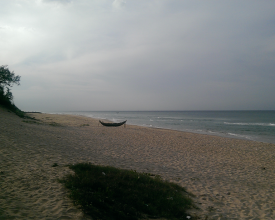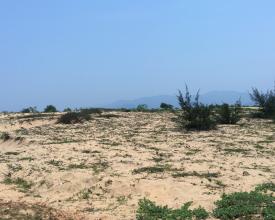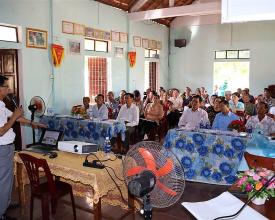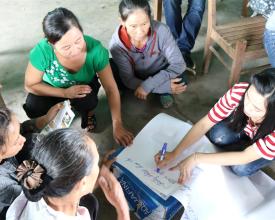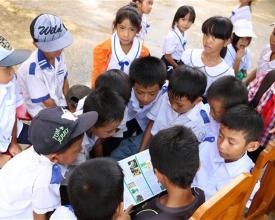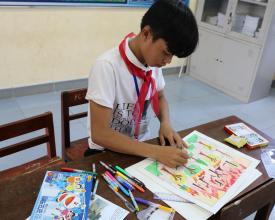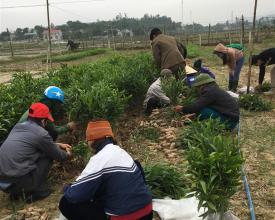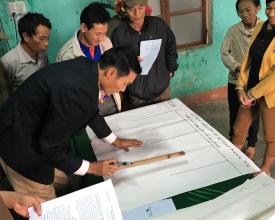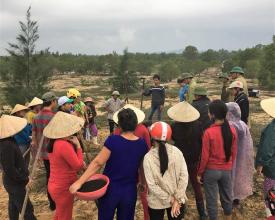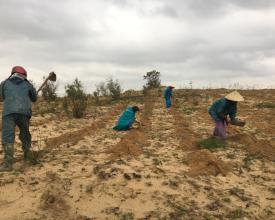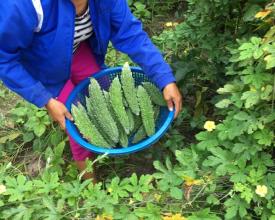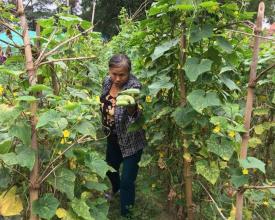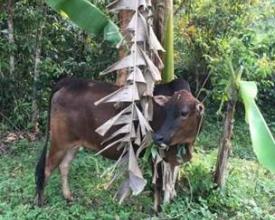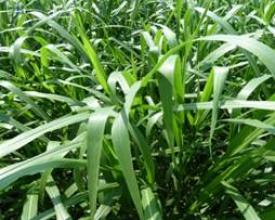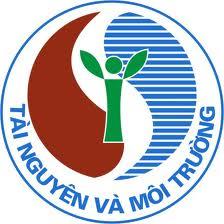
Reforestation and rehabilitation of sandy coastal protection forest along with short-term livelihoods development for local community
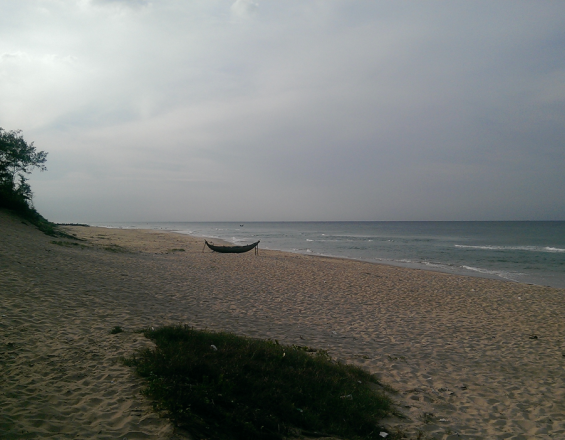
Hoa Binh village - located along the coastline in central Vietnam - is seriously exposed to strong storms, sea encroachment, sand moving, drought and coastline erosion. In addition, the village has approximately 123ha of sandy protection forest areas along a 3.5km coastal stretch. The forest was degraded because of bombing in the war, serious storms and over-harvesting of trees for firewood by local people, making the communities more vulnerable to climate change and extreme weather impacts.
Reforestation and rehabilitation of the coastal protection forest along with livelihood development activities for communities proved to be the most effective measure in reducing the vulnerabilty of local people. The pilot measure consisted of reforesting and rehabilitating 10 ha degraded sandy coastal protection forest as well as providing technical trainings and raising awareness among local communities
Context
Challenges addressed
Environmental: Coastal areas are one the most affected regions by climate change impacts in a country where rising sea levels and extreme storms can have detrimental impacts on both the economy and local livelihoods. The sand-dunes and coastal protection forests, which can play important role in protecting the innerland from sea-level rising and strong storms, are seriously degraded though. The rising sea levels and the lack of appropriate coastal protection measures can lead to salt water intrusion, salinization of drinking water and agricultural land, and sand-moving to agricultural production areas.
Social: Meanwhile, incomes of local people in the pilot site mainly depend on agricultural production. Changing climate conditions also lead to changes in agricultural production systems. In agro-ecological zones this can have long-lasting impacts on the local economy and livelihoods.
Location
Process
Summary of the process
The solution was identified via a series of studies and the assessment of the project (such as vulnerability assessment and studies on selecting potential EbA pilot measures) to select the most potential EbA pilot measure in the province. The project implementation started by raising awareness for local coastal communities via training courses on CC/CCA/EbA (Building block 1). This helped them to better understand climate change impacts and the increased value of available natural ecosystems from strengthening adaptive capacity and reducing serious impacts of climate change. The activity of reforestation and rehabilitation of coastal protection forests (Building block 2) aimed to restore natural sand-dune ecosystems which can reduce coastal erosion, form a protective storm-break against extreme weather events and sand-moving. Along with strengthening the adaptive capacity of communities and ecosystems, the provision of alternative livelihood options (Building block 3) is considered an effective approach to enhance the resilience of local communities towards climate change impacts.
Building Blocks
Awareness raising on Climate change and Ecosystem-based Adaptation for local coastal communities
Being located along the coastal line seriously exposes local people to natural hazards such as storms, floods, whirlwinds, sand-moving, river and sea bank erosion and salinity intrusion. The majority of populations in coastal areas is poor and has limited knowledge about climate change impacts. In 2016-2017, over 20 training courses were conducted for more than 1200 people from 10 coastal villages and local staff to provide practical knowledge and information on (ecosystem-based) adaptation to climate change, aiming to strengthen their understanding and their adaptive capacity towards impacts of climate change. During the training, local people had the chance to learn about climate change and project impacts in their region and globally, to discuss their challenges and worked out potential adaptation measures together. In addition, awareness raising on climate change was also conducted for about 300 pupils and teachers in primary and secondary schools in Ngu Thuy Nam commune. Participating in a picture drawing contest run under the title “Climate change in your home-village’’ increased their understanding on climate change issues and adaptation measures that they could contribute.
Enabling factors
- Training materials were prepared in a simple manner which made it easy for local people to understand: photos, leaflets, videos…
- Creating opportunities for local people to identify their challenges and to discuss potential adaptation measures that their community could carry out
- Active involvement of local authorities in the activities
- Mobilising participation of young generations, such as youth unions and students is a key success factor due to the important role they play in the action plan for responding to CC impacts in the area
Lesson learned
- Tangible examples/good practices on climate change impacts and EbA measures help local people and staff to get a better understanding about adaptation measures and their benefits.
- Taking challenges of local communities as entry points for the training's content
- Support and active involvement of the local authorities definitely increased the success of the activity
- Adaptation plans of communities need to be supported and followed up to ensure their sustainability
Reforestation and rehabilitation of coastal protection forest to restore biodiversities and ecosystem services in coastal areas.
The coastal protection forest plays an important protective function in safeguarding communities and land uses from extreme storms, rising sea levels, shoreline erosion, sand moving and salt water intrusion. Evidence has shown that by restoring coastal ecosystems, the protective functions of these ecosystems can be restored which in turn increases the resilience of coastal communities and ecosystems, while providing diverse additional benefits such as biodiversity conservation. In Hoa Binh village, the degraded proection forest causes the loss of the protective function of the forest and increases the vulnerability of local communities and adjacent land (villages, agricultural land, underground water sources…). Since 2016, the project has supported a pilot model of reforesting coastal sand-dune forests using a mix of species of acacia (wattle), casuarina (whistle pine) and native species (Melaleuca cajuputi, Myrsine linearis, Lithocarpus concentricus, Syzygium corticosum) on 10 ha of degraded land, classified as protection forest. The aim was to restore the costal forest and increase the resilience of coastal ecosystems and communities. The restoration activity has so far planted 5ha of acacia forest, another 5ha of casuarina and inter-planted 100 clusters of native species.
Enabling factors
- Existing local people’s basic awareness on the importance of protection forests to their lives in the context of increasing extreme events
- High commitment and ownership of local people and local authorities towards forest protection and rehabilitation
- Enhancing technical knowledge and skills of local people in forest plantation
- Close technical monitoring and and guidance of community forest protection groups
Lesson learned
- It takes time to discuss, persuade and raise awareness of local authorities and local communities on rehabilitating native species and mix-planting native species with the standard species (acacia and casuarina) that had been regulated in the forest plantation agenda of the government for coastal forests
- Room needs to be created for local people to raise their voice on how they would like to approach implementation
- High commitment and support from local authorities is needed at all levels for community forest protection groups to operate and carry out their work properly and sustainably
- Selection of good quality seedlings with support of technical experts is one of the key factors
- A maintenance plan as well as monitoring and evaluation is a crucial factor to decide the success of the pilot measures by local communities and authorities
Supporting livelihood development to enhance resilient coastal communities towards climate change impacts
Livelihood models were developed and piloted to support participating households, helping them to generate additional income and strengthening the ownership of the local community. 30 participating households were identified trough baseline surveys and three models were selected which had been identified as having the potential to reduce the pressure on coastal forests, while also providing additional benefits to communities. Vegetable gardening, fodder production & cattle raising as well as fish farming were identified to support selected farmers. As such, the livelihood activities are directly linked to the coastal protection forest plantation, not only by reducing pressures but also by enhancing the adaptive capacity of local communities through diversifying agricultural products. Ownership for the coastal protection forest plantation was also increased as locals partaking in the livelihood models have protection and maintenance responsibilities for the pilot plantations. A series of technical trainings on identified livelihoods, including guidances on farming were delivered to farmers to improve their technical knowledge and production skills.
Enabling factors
- Involvement of local authorities and communities from the start of first discussions about project planning
- The needs of local people are respected and taken into account
- Technical knowledge and regular advice play important roles in improving production skills for farmers
- Good collaboration and support from local authorities and project partners are key factors
Lesson learned
- It takes time for farmers to really understand and apply techncial knowledge and change their production habits to adapt to climate change impacts
- EbA measures usually take longer until its results and impacts can be seen. Short-time implementation of the solutions has not yet brought practical evidence of the biophysical effectiveness of measures which could be communicated to local authorities with facts and figures, making it hard to persuade them to take over responsibility on M&E and maintaining the solutions
- The restoration of ecosystems (medium-term benefits) in combination with livelihood development of local people (short-term benefits) is an integrated and sustainable approach in response to climate change impacts
- Ownership and responsibility of local communities for upscaling and maintaining pilot measures in the long run is a key factor to ensure their sustainability
Impacts
Environmental: Forest rehabilitation by mix-planting acacia (wattle), casuarina (whistling pine) and native species is expected to strengthen the adaptive capacity of ecosystems and local communities towards climate change impacts and extreme weather events. The restored forest serves as a strong wind-break, and as a sand-moving and sea erosion fence for the communities during the storm season. It also increases forest cover for climate-buffering and biodiversity conservation, improves soil humidity and serves as an underground water source.
Social & economic: Communication and ownership within the community is significantly strengthened via community-forest-protection groups. More than 3,000 residents are benefiting from this forest. Livelihoods have been improved in the short-term by using available local resources. Employment led to increade income between 30-50%. Ultimately, local peoples´ adaptive capacity is strengthened through developing diversified income streams based on sustainable and climate-smart practices. Additional 1,500 villagers from adjacent communities raised their awareness and were inspired by participating in training & field activities.
Beneficiaries
More than 3,000 local people in Hoa Binh village have directly benefitted from the solution. In addition, the awareness and adaptive capacity of more than 1,500 people from other coastal communes and provincial staff was strengthened.
Sustainable Development Goals
Story
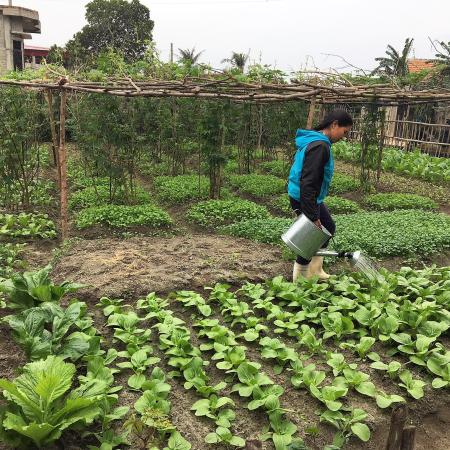
Mrs. Thuong’s family lives near the protection forest in Hoa Binh village in Quang Hung commune. Her family’s income mainly depends on agricultural production such as rice cultivation, pig raising, and inshore fishing by her husband. According to her mother who is now more than 80 years old, in her memory, the coastal sand dunes in the commune were covered with high density forest and various indigenous tree species that locals benefitted from. For example by collecting firewood and dried leaves for animal raising, through available water resources from sand-dunes for domestic use, and less impact by sand-moving and storm wind to resident locations compared to the current situation. Since then, about 30-40 years ago, the coastal protection forest was gradually destroyed because of bombing in the war, increased intensity of serious storms and over-harvesting of trees for firewood by local people. This makes communities more vulnerable to extreme weather events. In the last 10 years, the serious impact of extreme weather and strong storms has been seen more clearly by local people. Examples include sea-enroachment by about 10-20m inland, sand-moving to production areas and shortage of water during the hot season.
In addition, fishing by Mrs. Thuong’s husband brings less income compared to before because of a reduction of fishes in both quantity and quality caused by climate change. Her income from agricultural production has been facing problems by extreme weather, diseases and decreased quality of seedlings.
After 2 years with support from the project, she has learned a lot about climate change and adaptation measures, technical knowledge about vegetable farming (organic products) and diversity and resilience of seedlings for different crops. Mrs. Thuong and her mother are working together in her vegetable garden. Her family’s income has increased by 50%, so she can now afford food and sending her children to school. She is also a member of the community-forest protection group which works on afforestation and forest protection. Mrs. Thuong is very happy and told project staff she believes that in the coming years, the forest will surely bring many benefits for her family and community. Her family will no longer worry about strong storms, sand-moving problems, and underground water will be recovered soon for their production activities.
